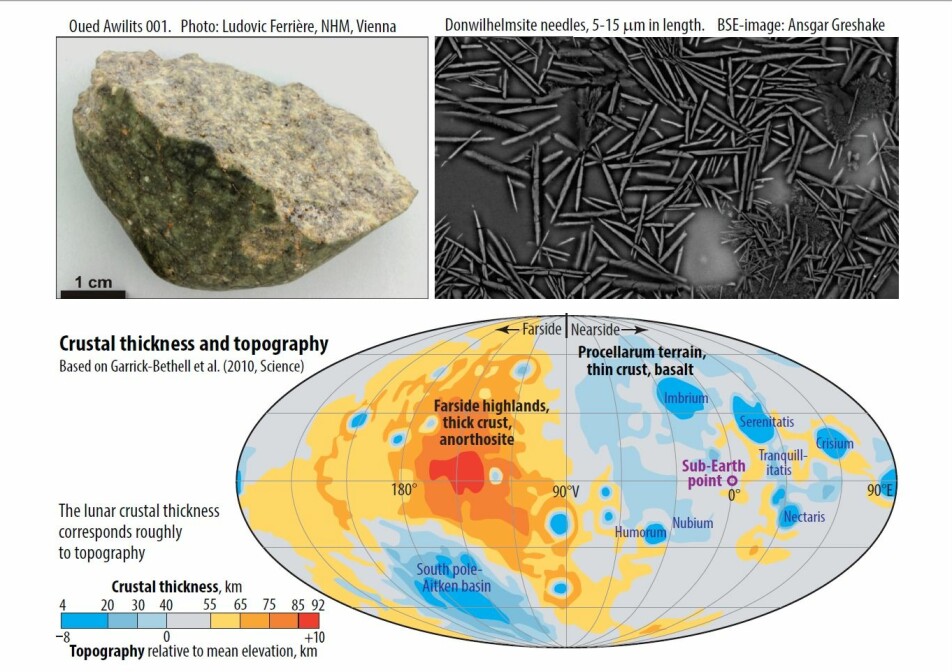A new mineral from the Moon - also present in the deep Earth
A European research effort with a contribution from the Natural History Museum and Centre for Earth Evolution and Dynamics at the University of Oslo has found and characterised a new mineral in the lunar meteorite Oued Awlitis 001. The mineral, named donwilhelmsite, is also present in minor quantities in the Earth's mantle, in the 460-700 km depth range.
The source region of the meteorite Oued Awlitis 001, containing the high-pressure mineral donwilhelmsite, was probably in the highlands on the lunar farside. The figure shows a fragment of Oued Awlitis 001, needle-shaped crystals of donwilhelmsite (BSE: back-scattered electrons) and a map showing the crustal thickness and topography of the Moon. The farside higland area with thick crust, shown by orange and red colours, are dominated by the rock type anorthosite with highly calcic plagioclase as the main mineral. The high pressure of 16-27 GPa, which is required to form donwilhelmsite, was generated by a collision shock caused by an asteroidal object hitting the Moon. Donwilhelmsite, with chemical formula CaAl4Si2O11, crystallised from the resulting shock-melted plagioclase with a composition broadly similar to CaAl2Si2O8.

Download the figure as a high quality PDF
The donwilhelmsite crystallisation in shock-melt veins happened late in the lunar history. The meteoritic material was ejected from a depth of at least 4 meter below the surface only about 300 000 years ago. Some of the ejected material escaped the gravitational field of the Moon, ended up in unstable orbits around the Earth, and eventually impacted on the Earth's surface. The inventory of cosmogenic nuclides (types of atomic nuleii formed by space radiation) put constraints on the pre-ejection depth exceeding 4 meter and the short time period since ejection from the Moon. The mineralogy and structure of the Oued Awlitis 001 meteorite, however, indicate that its source region also underwent severe shock-melting caused by a much larger impact early in the history of the Moon.
In the Earth's deep interior, donwilhelmsite is generated in former sedimentary rocks in the uppermost part of oceanic lithosphere, sinking through the mantle below subduction zones. Such zones, occurring along the margins of the Pacific, under Indonesia and within the Mediterranean region, are formed where dense oceanic plates sink under other, less dense, oceanic or continental plates. Donwilhelmsite crystallises at a depth of about 460 km within the oceanic sediments of either terrigenous or pelagic origin, at the expense of the minerals kyanite and clinopyroxene. The resulting increase in density gives the cold and dense oceanic plates a small added driving force for the further descent through the mantle transition zone (410-660 km depth) and the uppermost part of the lower mantle. At depths exceeding 700 km, donwilhelmsite will gradually break down to Ca-perovskite (CaSiO3-perovskite) and an Al-rich mineral with Ca-ferrite structure.
Because the content of donwilhelmsite in the sedimentary rocks is only 7-10 volum%, the excess density contribution to the sinking plates is quite limited. The elevated density, however, might prevent the oceanic sediments from peeling off the upper parts of the oceanic plates while they are sinking through the weak rocks (low viscosity) of the transition zone and into the highly viscous rocks of the lower mantle. Three-dimensional imaging of the Earth's interior based on the differential speed of earthquake waves (seismic tomography) indicates that subducted oceanic plates sink all the way to the lowermost mantle. The chemistry of basaltic lavas on volcanic islands like Iceland, the Azorens, Hawaii, Galapagos, Samoa and Reunion shows a significant contribution of recycled and partly remelted oceanic crust, including oceanic sediments of terrigenous and pelagic origin. Old and variable model ages based on the lead isotopic compositions of such basaltic rocks demonstrate that the recycled material has been stored for up to 2600 million years in the lower mantle.
The main volcanic islands are built by volcanism initiated near the top of rising plume channels with hot but solid rocks, ascending from the D" zone just above the core-mantle bondary. The volcanism results from partial melting within the upper 100-200 km below the surface. At a deeper level of about 460 km depth, the breakdown of donwilhelmsite in recycled sediments, incorporated in such hot plumes, might be accompanied by the release of small melt fractions of less than 1-2%. Such low-degree melts might contribute to the chemical diversity of some alkaline basalts and kimberlites.
Oued Awlitis 001 was found in Western Sahara in 2014. The investigated fragment was acquired by the Natural History Museum in Vienna with support from The Barringer Crater Company and through a crowd-funding campaign organised by Ludovic Ferrière. The new mineral downwilhelmsite is named after Don Edward Wilhelms, a former United States Geological Survey geologist who contributed to geologic investigations and mapping of the Moon and training of the Apollo astronauts: https://en.wikipedia.org/wiki/Don_Wilhelms
The scientific article, containing further references, is published in American Mineralogist:
News articles published by the University of Manchester and Der Spiegel:
Other articles (in Norwegian) about the Moon and the Apollo program:
https://forskning.no/kronikk-geofag-romfart/kronikk-apollo--et-geovitenskapelig-gjennombrudd/1182457







